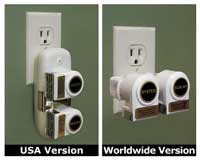|
Electromagnetic Fields And
Public Health:
Mobile Phones Part 2

Cell Tower
Life Bluetube Headsets
Cell Phone Towers Health Effects
EM Field Meter
Cell Phone Sensitivity
Long-term effects
Epidemiological research examining potential long-term risks
from radiofrequency exposure has mostly looked for an
association between brain tumours and mobile phone use.
However, because many cancers are not detectable until many
years after the interactions that led to the tumour, and
since mobile phones were not widely used until the early
1990s, epidemiological studies at present can only assess
those cancers that become evident within shorter time
periods. However, results of animal studies consistently
show no increased cancer risk for long-term exposure to
radiofrequency fields.
Several large multinational epidemiological studies have
been completed or are ongoing, including case-control
studies and prospective cohort studies examining a number of
health endpoints in adults. The largest retrospective
case-control study to date on adults, Interphone,
coordinated by the International Agency for Research on
Cancer (IARC), was designed to determine whether there are
links between use of mobile phones and head and neck cancers
in adults. The international pooled analysis of data
gathered from 13 participating countries found no increased
risk of glioma or meningioma with mobile phone use of more
than 10 years. There are some indications of an increased
risk of glioma for those who reported the highest 10% of
cumulative hours of cell phone use, although there was no
consistent trend of increasing risk with greater duration of
use. The researchers concluded that biases and errors limit
the strength of these conclusions and prevent a causal
interpretation. Based largely on these data, IARC has
classified radiofrequency electromagnetic fields as possibly
carcinogenic to humans (Group 2B), a category used when a
causal association is considered credible, but when chance,
bias or confounding cannot be ruled out with reasonable
confidence.
While an increased risk of brain tumors is not established,
the increasing use of mobile phones and the lack of data for
mobile phone use over time periods longer than 15 years
warrant further research of mobile phone use and brain
cancer risk. In particular, with the recent popularity of
mobile phone use among younger people, and therefore a
potentially longer lifetime of exposure, WHO has promoted
further research on this group. Several studies
investigating potential health effects in children and
adolescents are underway.
Exposure limit guidelines
Radiofrequency exposure limits for mobile phone users are
given in terms of Specific Absorption Rate (SAR) – the rate
of radiofrequency energy absorption per unit mass of the
body. Currently, two international bodies 1, 2 have
developed exposure guidelines for workers and for the
general public, except patients undergoing medical diagnosis
or treatment. These guidelines are based on a detailed
assessment of the available scientific evidence.
WHO'S response
In response to public and governmental concern, WHO
established the International Electromagnetic Fields (EMF)
Project in 1996 to assess the scientific evidence of
possible adverse health effects from electromagnetic fields.
WHO will conduct a formal risk assessment of all studied
health outcomes from radiofrequency fields exposure by 2012.
In addition, and as noted above, the International Agency
for Research on Cancer (IARC), a WHO specialized agency, has
reviewed the carcinogenic potential of radiofrequency
fields, as from mobile phones in May 2011.
WHO also identifies and promotes research priorities for
radiofrequency fields and health to fill gaps in knowledge
through its research agendas.
WHO develops public information materials and promotes
dialogue among scientists, governments, industry and the
public to raise the level of understanding about potential
adverse health risks of mobile phones.
Electromagnetic Fields And Public
Health: Mobile Phones Part 1
Tajikistan, Dushanbe
Lebanon, Beirut
Singapore, Singapore
Mesquite Texas USA
Costa Rica, San Jose,
Korea South) Seoul, City
Algeria, Algiers
Ecuador Quito
United States, Washington D.C.
Tanzania, Dar es Salaam
http://www.emfnews.org/store |








